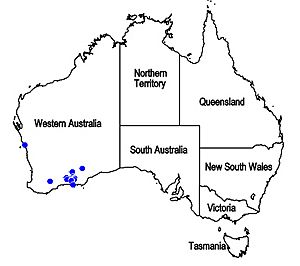Pityrodia chrysocalyx facts for kids
Quick facts for kids Pityrodia chrysocalyx |
|
|---|---|
| Conservation status | |
| Scientific classification | |
| Genus: |
Pityrodia
|
| Species: |
chrysocalyx
|
 |
|
| Occurrence data from the Atlas of Living Australia | |
Pityrodia chrysocalyx is a beautiful flowering plant. It belongs to the mint family, called Lamiaceae. This plant grows only in the south-west part of Western Australia. It is a bushy shrub with shiny leaves. Its flowers have white petals and a bright golden-yellow cup-like part called a calyx.
Contents
About the Golden-Cupped Pityrodia
Pityrodia chrysocalyx is a straight, bushy shrub. It usually grows to be about 30 to 75 centimeters (12 to 30 inches) tall. Its branches are covered with small, reddish-yellow, round scales.
Leaves and Flowers
The leaves of this plant are glossy green. They are shaped like an egg and are about 2 to 6 centimeters (1 to 2 inches) long. They are also about 1 to 3 millimeters (0.04 to 0.12 inches) wide. You can often find them in groups of three along the stems.
The flowers grow one by one where the leaves meet the stem. Each flower has a small, leaf-like part called a bract at its base. The flower has five sepals, which are like small leaves that protect the bud. These sepals join together to form a golden, bell-shaped tube. This tube is about 5 to 7 millimeters (0.2 to 0.3 inches) long. It is scaly on the outside and smooth inside.
The five petals of the flower are white and joined together. They form a tube about 9 to 12 millimeters (0.4 to 0.5 inches) long. This tube is wider at the top. The bottom, middle petal lobe is broad and almost round. It is about 3 to 5 millimeters (0.1 to 0.2 inches) wide and long. The other four lobes are a bit smaller.
Flowering and Fruit
The petal tube has a few soft hairs on the outside. Inside, it is smooth, except for a ring of dense hairs above the ovary. There are also a few hairs on the largest petal lobe.
This plant usually flowers from July to October. After flowering, it produces a hairy, oval-shaped fruit. The fruit is about 4 to 5 millimeters (0.16 to 0.20 inches) long. The sepals stay attached to the fruit.
Plant Name and History
This plant was first officially described in 1876. A botanist named Ferdinand von Mueller gave it the name Depremesnilia chrysocalyx. He published his description in a book called Fragmenta phytographiae Australiae.
In 1931, another botanist, Charles Gardner, changed its name. He renamed it Pityrodia chrysocalyx.
Meaning of the Name
The second part of the plant's name, chrysocalyx, comes from ancient Greek words. "Chryso" means "gold," and "calyx" means "cup." So, chrysocalyx means "golden-cupped." This name refers to the golden color of the sepal tube on the flower.
Where It Grows
This type of pityrodia plant likes to grow in sandy soil in open woodlands. You can mostly find it in Western Australia. It grows in areas between Esperance, Norseman, Lake Meads, and Pyramid Lake. These areas are part of the Coolgardie and Mallee biogeographic regions.
Looking After This Plant
The Western Australian Government's Department of Parks and Wildlife has classified Pityrodia chrysocalyx as "Priority Three". This means we don't know a lot about this plant. It is found in only a few places. However, it is not currently in immediate danger of disappearing.


